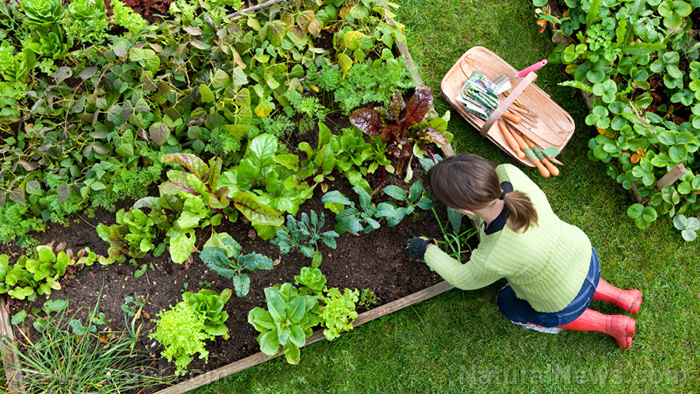Food supply 101: Tips for preparing a healthy food stockpile
10/31/2022 / By Zoey Sky

The items in your survival stockpile may include a lot of shelf-stable food, but that doesn’t mean you have to eat meals that aren’t nutritious when SHTF.
If you don’t want to feed your family food with empty calories, plan ahead and stock up on healthy items like fruits, vegetables and grains. (h/t to TheSurvivalMom.com)
To get started, try answering some important questions.
When disaster strikes, how long can you live off your pantry? Is it one week or several months? If you’re stuck at home, will you have enough food for the whole family?
You should also stock up on fruit, vegetables, grains, protein and fat so you have ingredients to prepare healthy and balanced for your family. If you or someone in the family has food allergies or sensitivities, adjust the items as needed.
Week 1 SHTF menu ideas
After SHTF, you should consume all perishables during week one since these items must be used up first, especially if you are dealing with a long-term power outage in the area.
Come week two, you can move on to the canned, dehydrated and freeze-dried foods in your stockpile.
Week 2 SHTF menu ideas
If you are still bugging in for a second week, start using up any deli meats you still have in the fridge. You should also cook fresh and frozen meats before they spoil.
Other food items that must be used up by week two include fresh fruits and veggies, eggs, milk and mayo.
If you still have electricity, use this time to dehydrate or can your remaining food. If you don’t have power, but have a camp stove and fuel, consider canning food outside.

Key components of a healthy food storage system
Before disaster strikes, you should stock up on healthy ingredients like fruits, vegetables, grains and spices.
Fruits
Fruits are an important part of a balanced diet, but you need to get a little creative when including fruit in a survival meal plan.
First, you should use up fresh fruit before it spoils. Next, use up any canned, dried and freeze-dried fruit in your stockpile.
You can buy dried fruits like blueberries, cranberries and raisins in grocery stores. Alternatively, you can stock up on freeze-dried fruits. If you dehydrate fruits, you’ll have more ingredients to choose from.
Here are some ideas on how to use up fruits in your stockpile:
- Use bananas and apples when baking bread.
- Add chopped fruits to oatmeal for breakfast.
- Use frozen fruits to make breakfast smoothies.
Vegetables
It can be difficult to stock up on fresh vegetables, but another alternative is to buy canned vegetables for your stockpile.
Find out which vegetables your family likes to eat, then stock up before SHTF. You can buy canned veggies like asparagus, beets, corn, green beans, mushrooms and peas at the grocery store.
You can also stock up on frozen, freeze-dried and dehydrated vegetables. If you have a food dehydrator, you can also dehydrate veggies and fruits for your stockpile.
Fresh greens
If you want to stock up on fresh greens, you can learn how to grow sprouts or microgreens. Microgreens are easy to grow and they are full of micronutrients. Use them on sandwiches and salads.
Another option is to dehydrate microgreens and add them to green powder or flour if you don’t eat them up that quickly.
Proteins
Protein is also crucial for a balanced diet and emergency food storage. Common protein sources include meat, poultry, seafood, eggs, nuts and seeds.
Beans are incomplete proteins, but combining them with grains makes them a complete protein. Rice and beans are a popular combination and can be cooked in many different variations to prevent food boredom.
Before SHTF, stock up on:
- Canned chicken
- Canned salmon
- Canned tuna
- Corned beef
- Minced clams
- Packets of tuna and salmon
- Spam
Use protein powders to give oatmeal and other foods a protein boost.
Flours, grains and legumes
Oatmeal is a grain that’s perfect for breakfast, but you can also add it to other recipes to stretch them out for more servings.
Aside from oats, other grains that are nutritious and easy to store include rice, various types of wheat and millet.
Dairy items
A nutritious pantry menu should also include fresh foods like eggs, cheeses and milk. These good protein sources are also common ingredients in many sweet and savory recipes.
These items require power to stay fresh, but if you’re worried about a long-term power outage, you can stock up on powdered and freeze-dried dairy products.
For example, butter, eggs and milk are all available in powdered form. Also, freeze-dried cheese is just as good as fresh when rehydrated. (Related: Prepping essentials: 11 Forever foods for your food storage pantry.)
Powdered whey, which is also an excellent protein boost, can be added to baked goods, oatmeal and pancake.
Spices and seasonings
A prepper’s pantry should also include a variety of flavorful spices and seasonings for healthy food storage. These ingredients will help keep nutritious meals interesting and avoid food fatigue or food boredom, especially when you are dealing with a long-term survival scenario.
Spices and seasonings have a long shelf life if you store them in a cool, dark location.
Here are some spices and seasonings to stock up on before SHTF:
- Chili powder
- Cumin
- Garlic powder
- Herbs (fresh and dried)
- Nutritional yeast
- Oils
- Onion powder
- Paprika
- Pepper
- Red pepper flakes
- Salt
- Vinegar (Apple cider vinegar, white vinegar, etc.)
Stock up on seasoning mixes like barbeque rub mix, gravy powder mix, Italian herb mix and taco seasoning mix.
Flavorful seasoning mixes can also be used for scrambled eggs, popcorn and roasted potatoes. If you have canned beans, stock up on ham bones or ham hocks to flavor ham and bean soup.
Cooking oils and fats
You need cooking oils and fats for frying and baking, so stock up on pantry essentials like butter, lard and oils. Cooking oil and fats help transport vitamins and flavors to foods.
In fact, sauteing onions, pepper and celery in olive oil or butter carries the flavors of the food you’re preparing.
Keep butter in an upright freezer and store ghee at room temperature. You can also buy butter powder if you don’t have an upright freezer for storage.
Keep in mind that mayonnaise keeps well until opened.
Crisco and lard don’t need to be refrigerated and you can use these ingredients to make a pie crust for a savory meat pie or a dessert. Solid shortenings aren’t usually considered healthy, but can be part of your survival preps.
Cooking oils will last for at least one year or so without going rancid. You can extend the shelf life of oils by storing them in the refrigerator or freezer.
Coconut oil has a longer life span and olive oil should last at least one year. Make the most of your preps by buying canned salmon, sardines and tuna in oil, not water, for a healthy source of protein and omega-3 fatty acids.
Fill nutritional gaps with supplements and multivitamins
Despite the most meticulous planning, you will still need to fill the nutritional gaps in your survival stockpile by stocking up on supplements and multivitamins.
Plan accordingly and if you have kids at home, stock up on comfort foods like snacks or chocolate. Even adults can cheer up when SHTF if you have candy to share. Save money by stocking up on Halloween candy by November and store the candy in vacuum bags to keep it fresh.
Before SHTF, stock up on nutritious food items like canned fruits and vegetables and grains so your family can eat healthy meals even after disaster strikes.
Watch the video below to learn how long canned food lasts in your stockpile.
This video is from the High Hopes channel on Brighteon.com.
More related stories:
Food storage tips: 11 Superfoods that boost your nutrient intake.
5 Food storage lessons from World War II.
Honey, powdered milk, salt and wheat: Survival cooking with the 4 basics of food storage.
Sources include:
Submit a correction >>
Tagged Under:
bug in, clean foods, emergency food, food freedom, Food storage, food supply, fruits, Homestead, off grid, organics, preparedness, prepper, prepping, SHTF, survival, survival food, sustainable living, vegetables
This article may contain statements that reflect the opinion of the author




















